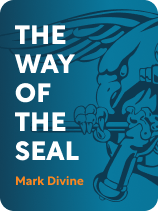

This article is an excerpt from the Shortform book guide to "The Way of the SEAL" by Mark Divine. Shortform has the world's best summaries and analyses of books you should be reading.
Like this article? Sign up for a free trial here.
Are you struggling as a business leader? How do you use your strengths to lead your team to victory?
In The Way of the Seal, Mark Divine says that business leaders must adopt a SEAL mindset to navigate the challenges of the modern work world. He examines four actions you can take to identify and tap your inner strengths so you can operate at your highest level.
Here’s how to use your strengths to become a powerful leader.
Action 1: Identify Your Core Compass
Divine says that to learn how to use your strengths as a leader in a chaotic, evolving work world, you must first connect with your inner compass—the internal force based on your values and goals that guides you. This will prevent you from getting thrown by obstacles that arise and keep you focused so you can operate from your greatest point of strength.
For example, imagine that you’ve been offered a promotion at work but your inner compass hinges on a stable family and home life. The promotion will earn you extra money, but also require that you spend more time at work—including on weekends when you usually watch your kids’ sports games. You decide to turn down the promotion because spending time with your family is more important to you than the extra money from the promotion.)
To identify your inner compass, you have to know what you care most about in life (your values), what fundamentally motivates you, what you feel passionate about, and what an ideal version of yourself looks like.
Action 2: Focus Intensely On Your Goals
Divine says that to connect with your inner power and be a strong leader, you must focus on your goals with a high level of intensity—what the Navy SEALS call “front sight focus,” or, intensely and narrowly focused like you’re aiming through the front sight of a gun. When you place your whole focus on achieving each small goal in front of you you won’t get distracted by obstacles. This will allow you to stay calm and will give you a sense of accomplishment each time you achieve a goal, increasing your confidence and helping you operate at your best.
Divine says the Navy SEALs used front sight focus to break large tasks into small ones and capture Osama bin Laden. The SEALS didn’t know where to find bin Laden, so instead they found and interviewed smaller targets who could lead them to him. Each person provided information that led to the next—until, eight years later, the SEALS finally located and killed bin Laden.
To focus intensely on your goals, avoid distractions, and overcome obstacles you encounter while trying to achieve your goals, Divine says you have to manage your squirrely mind.
Action 3: Confront Your Fear and Unleash Your Potential
Divine says that to tap your inner power and operate at your peak, you have to step out of your comfort zone and confront your fears. Your comfort zone makes you feel safe but is actually a prison. It allows you to live in a state of fear of the unknown. This makes you reluctant to try new things and prevents you from growing.
The only way to escape the comfort prison is to seek out and do things you’re scared of. When you push your limits and find you can conquer challenges you didn’t think you could, your understanding of yourself expands—leading to greater confidence and growth.
Completing a terrifying challenge taught an executive who Divine took on a rappelling trip that he could confront and survive his worst fears. Midway down a 100-foot cliff in Mexico, Divine directed the executive—who had a fear of heights—to take things “one step at a time.” But as the executive descended he panicked, flipped upside down, and started screaming for help. Divine shouted at him to stop screaming and focus by closing his eyes and breathing deeply. The executive did as instructed, regained control, and safely reached the ground.
To step out of your comfort zone and face your fears, Devine says you should welcome new challenges:
- Schedule challenges for yourself once a week, month, and year. This will force you out of your comfort zone regularly, making the process less painful and fear-laden.
- Meet challenges with positive self-talk and a smile. This allows you to assert control in the new situation and reminds you that pain you experience along the way is part of the process of achieving a bigger goal.
- Make discipline, drive, and determination a habit. Cultivate discipline to help build habits, drive (the reason why you do things), and determination (your commitment to the action you’re carrying out). This creates a positively reinforcing cycle that supports your ability to continually take on new challenges.
Action 4: Bolster Your Mental Fortitude
Divine says strong leaders are mentally tougher than everyone else and refuse to give up during life’s most challenging moments. In other words, they have “grit.” This mental toughness comes from honing their ability to:
- Manage their physical and emotional response
- Turn negative self-talk that hampers performance into positives and tap the power of their subconscious
- Visualize their success
Together, these skills can help you tap your inner power and function at your best. (Shortform note: There’s a long history of people training their minds to overcome adversity. In The Obstacle Is The Way, Ryan Holiday explains that the Stoics considered themselves mental athletes. They trained their mental muscles to build “Inner Citadels” impervious to hardship. Other historical figures took this a step further, using disadvantages they were born with to motivate them. For example, Theodore Roosevelt struggled with debilitating asthma as a child but worked out daily and eventually overcame it. He said this training prepared him to endure more difficult moments, like his wife’s death, election losses, and assassination attempts.)

———End of Preview———
Like what you just read? Read the rest of the world's best book summary and analysis of Mark Divine's "The Way of the SEAL" at Shortform.
Here's what you'll find in our full The Way of the SEAL summary:
- A former Navy SEAL's strategies to help business leaders
- A mind-body technique that combines yoga, martial arts, and SEAL training
- How to bolster and harness your mental fortitude






